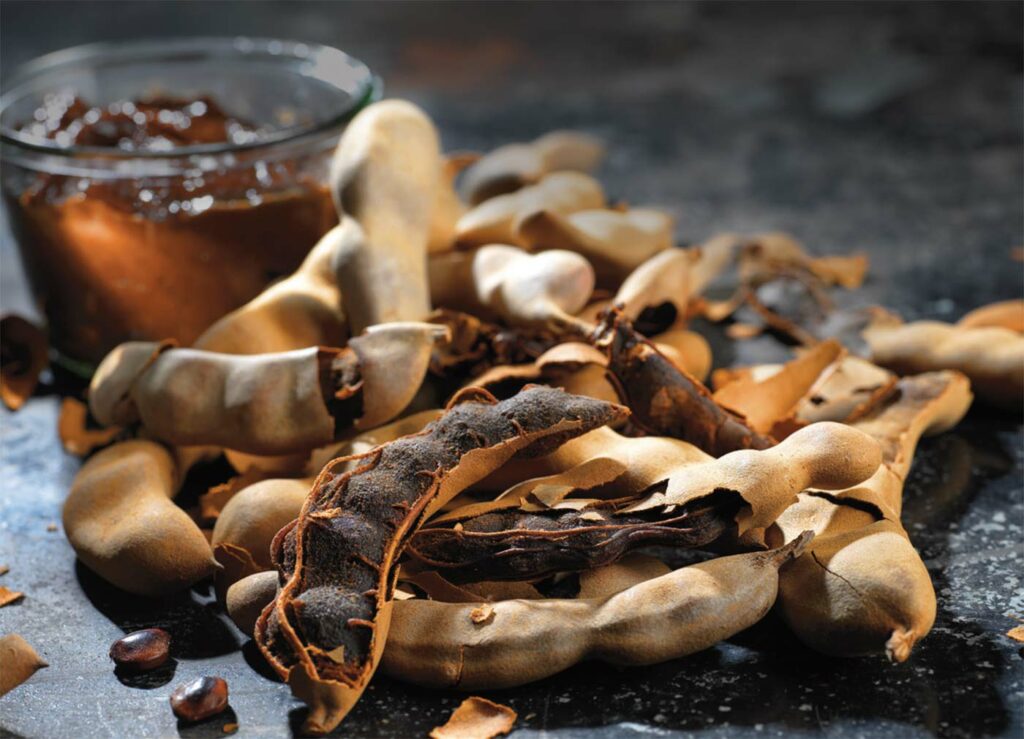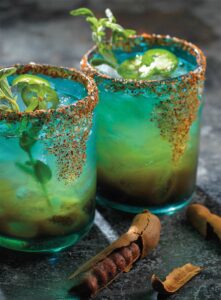
New and familiar dishes and drinks bring a once exotic fruit to our table
PHOTOGRAPHY BY PATRICK TREGENZA
The tastes we remember from childhood speak gently to our similarities and differences.
Nostalgic memories might begin with pasta, peanut butter, pancakes, or—if you grew up in Mexico like me—there was always sour, sugary and spicy tamarind.
The joy of its discovery came with finding chile-covered tamarind candies among the treasures of a piñata, gliding with friends through endless conversations paired with bites of that tasty brown mass and sticky fingers that relay a sense of belonging.
It might also have been the thrill of freedom and adventure rushing out to the corner shop to enjoy that familiar taste.
Maybe it is the feelings we associate with those flavors that keep us returning. All those “grown up” spins on childhood favorites have a strong reason to exist.
PATH TO PALATE
How a member of the leguminous family that originated in Africa ended up in some of our stories is due to centuries of exchange, getting to know each other better and sharing what our childhood tasted like.
Tamarind trees thrive in warm humid climates and are often grown for beauty as much as their fruit. Their name of Arab origin, means Indian date, probably because of its flavor and it being part of trade first along the Pacific and Indian oceans, and later, the Atlantic. The fruit presents like a thick fava bean pod which, when mature, hardens a thin crust with a woody appearance that looks just beautiful piled up in markets.
Inside, a few long fibers hold together sticky brown pulp that surrounds its seeds.
Its flavor could be described as a mostly tangy mix of date, apricot and lime. The delicately shaped flowers the tree produces, yellowish with orange or red streaks, are edible too, as are the sour and tender new leaves, which can be pickled.
In Southeast Asia, tamarind is often added to enrich soups, and is a great booster for any seafood or poultry-based broth. It is also the protagonist of the flavor profile of pad Thai, and many other noodle and rice dishes.
After tamarind came from Asia to the Americas, it has been used mostly in drinks, and—in Mexico, Brazil and many Caribbean and other Latin American countries—to make candies by combining the pulp with sugar, salt and sometimes chile in a thick mass meant to be shared. It is also used in frozen pops and sorbets.
In Mexico, it has found new expression in recent decades by being incorporated into moles and savory sauces.
Back in its African homeland, tamarind is generally cooked as part of curries and sauces, and paired with rich meats like lamb and goat, because unlike citrus, even if simmered long, it won’t lose its sour notes. In India it is widely combined into stews, pickles, rice dishes and chutneys.
Tamarind is also present in Jewish cuisine, particularly in chicken, salad and ground meat dishes. And yes, it is one of the main ingredients in Worcestershire sauce.
SIMPLE AND SPECIAL
When it comes to applying it in your home kitchen, there’s no need to complicate things. All you need is to add a tablespoon of tamarind purée to elevate any dish or drink.
Combine it with soy sauce for seared tuna or salmon, or anywhere you would use teriyaki.
Mix it with maple syrup for an outstanding glaze for fish, chicken or shrimp.
Glaze carrots, cauliflower or rice with tamarind and butter.
Use it in your salads anywhere where vinegar or citrus would be.
It does absolute wonders for rich meats like duck or pork, particularly belly or bacon, or complex flavors like hearty mushrooms and beef stews.
Tamarind combines very well with chile of course, but also mango, citrus, pineapple, ginger, and even milk or white chocolate. In the cocktail world it offers infinite possibilities. It’s all about playing and having fun with it.
Finally, a few notes on how to extract tamarind pulp.
Break the outer woody shell and pull the stem that holds the long fibers, place pods in a stainless steel or enamelware container. Boil enough water to cover them and let stand for 30 minutes. If pods are older and drier, you might need to simmer them for a few minutes.
Stirring with a spoon, separate the pulp from the seeds. Sieve the pulp, pushing the seeds with a spatula through a strainer to get the most out of them, and reserve. You may also use a food mill strainer, especially when working with larger quantities.
If you’d like to sweeten the purée, a good ratio is about 4 tablespoons of sugar per cup of pulp and adjust to taste. You can fine-tune the consistency by adding water or simmering to thicken, depending on the use.
Refrigerated fresh tamarind purée lasts about a week, but it freezes well.
Pods as well as tamarind paste are sold in southeast Asian markets. Sometimes the paste has seeds, just combine it with hot water and strain before using. It is also sold jarred without seeds, making it very accessible for a quick improvement on any dish.
Latin American markets sell pods year-round and a sugary concentrate for aguas frescas, or cocktails. Just read the label to ensure the main ingredient is tamarind pulp.


About the author
Analuisa Béjar loves exploring flavor routes as the chef at her Sunny Bakery Cafe in Carmel Valley. She is a recent transplant from Mexico City, where she was a food critic, award-winning writer, editor, recipe developer, culinary teacher and organizer of Latin American gastronomy competitions.
- Analuisa Béjarhttps://www.ediblemontereybay.com/author/analuisabejar/
- Analuisa Béjarhttps://www.ediblemontereybay.com/author/analuisabejar/
- Analuisa Béjarhttps://www.ediblemontereybay.com/author/analuisabejar/
- Analuisa Béjarhttps://www.ediblemontereybay.com/author/analuisabejar/


